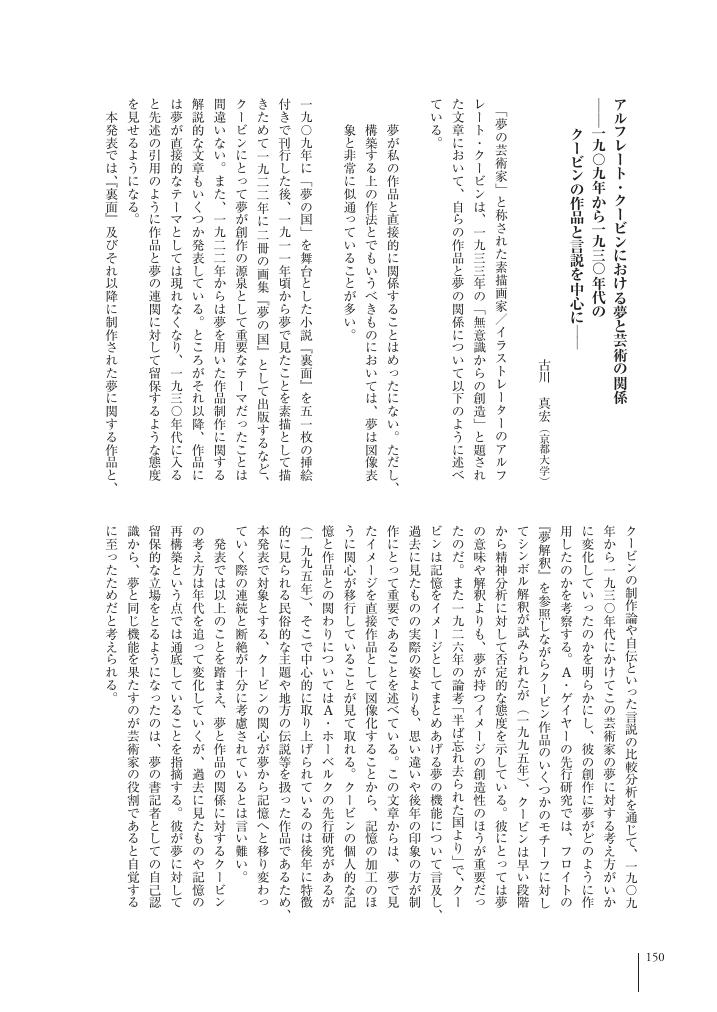- 著者
- 古川 真宏
- 出版者
- 美学会
- 雑誌
- 美学 (ISSN:05200962)
- 巻号頁・発行日
- vol.69, no.1, pp.150, 2018 (Released:2019-06-01)
2 0 0 0 OA アルフレート・クービンにおける夢と記憶 一九〇九年から一九三〇年代の作品と言説を中心に
- 著者
- 古川 真宏
- 出版者
- 美学会
- 雑誌
- 美学 (ISSN:05200962)
- 巻号頁・発行日
- vol.69, no.1, pp.85, 2018 (Released:2019-06-01)
Alfred Kubin (1877-1959) was once called “dream artist” on the art journal Kunstblatt in 1903. In fact, dream was a subject of importance for him; he made several drawings, and wrote a novel and some essays with the theme of dream, such as Traumland I and II (1922), 2 bands of picture books consisting of lithographs capturing what he saw in his dreams, and his famous novel Die andere Seite (1909). However, he came to take a negative attitude toward dream after 1922, instead, his main interest seems to have been shifted to memory. Taking notice of such a change of his position, this paper investigates Kubin’s thinking of dream and memory, and how he applied his understanding of them to his work. Also, I would compare his methodology and psychoanalysis in terms of the concepts “secondary revision” and “screen memory” in order to clarify the uniqueness of Kubin’s image composition. In conclusion, his change of interest from dream to memory is not a break with his previous way of creation but rather a continuous development, which was resulted from the internalization of the mechanism of dream. In brief, he took advantage of the unconscious psychic mechanism of memory to generate new visual images.
- 著者
- 古川 真宏
- 出版者
- 美学会
- 雑誌
- 美学 (ISSN:05200962)
- 巻号頁・発行日
- vol.64, no.1, pp.194-195, 2013-06-30 (Released:2017-05-22)
2 0 0 0 世紀末ウィーンにおける芸術と精神医学に関する研究
本年度は、「世紀末ウィーンにおける芸術と精神医学」についてのこれまでの研究の成果をまとめ、論文「世紀末ウィーンの芸術における病理学的身体――クリムト的女性像に関する一考察」として紀要『ディアファネース――芸術と思想』(査読有)で発表した。この論文は、当時「世紀の病」として広く認知されるようになったヒステリーと精神衰弱という二つの病の観点から、様々な芸術分野に対する精神医学の影響をまとめたものである。当論文では、世紀転換期の女性像を芸術批評・医学的言説・図像との比較・分析を通じて、ヒステリー的ファム・ファタールと神経衰弱的ファム・フラジールの二つの類型に分類した。また、グスタフ・クリムト、エゴン・シーレ、オスカー・ココシュカの作品、臨床の現場における神経衰弱の女性像、シュルレアリスムにおけるヒステリーの女性像などと比較することで、芸術的主題としての病理学的身体の系譜を描き出した。また、前年度の研究のテーマであった「スタイルとモード」という問題系についても同時に研究を進めた。その研究過程で重要な参照項として浮かび上がってきたゴットフリート・ゼンパーの様式論とアンリ・ヴァン・デ・ヴェルデの服飾論については、加藤哲弘編『芸術教養シリーズ28芸術理論古典文献アンソロジー西洋篇』において、解説・抄訳のかたちで概要を発表した。また、このテーマに関する論文「ウィーンの/とファッション」(仮題)は、池田裕子編『ウィーンー総合芸術に宿る夢』(竹林舎、2016年春刊行予定)に掲載されることが決定している。

